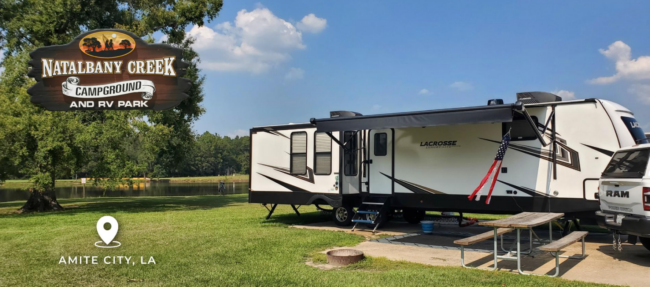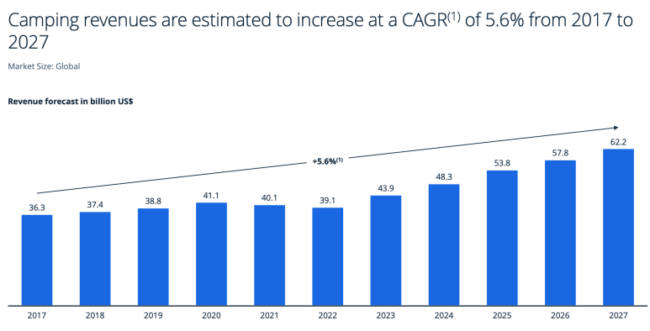How to Create a Winning RV Park Business Plan
Whether you’re an entrepreneur seeking a new business venture or an existing RV park owner looking to expand, developing a comprehensive business plan is crucial to your success.
A well-crafted business plan allows you to examine the market, pinpoint your target audience, and create a foundation for financial projections and growth strategies.
You’ll also need one when seeking funding from banks or investors.
Whether you’re an RV’er or not, here’s the deal. The RV park industry is seeing tremendous growth, attracting more and more people seeking to escape the hustle and bustle of everyday life.
With that comes the need for well-thought-out RV park business plans encompassing various aspects of market research, marketing strategies, operational plans, and financial forecasting.
Keeping these factors in mind as you craft your business plan will lead to a stronger, more sustainable business over the long term.
Key Takeaways
- A comprehensive business plan is essential for success in the growing RV park industry.
- Consider market research, target audience, and financial projections when creating your plan.
- A well-developed plan acts as a foundation for operational strategies and attracts potential investors.
What Are RV Parks?
Before we get into what’s involved with writing a good RV park business plan, let’s first define what an RV park is in the first place.
An RV Park is a venture where people with recreational vehicles (RVs) have a spot to stay overnight or longer in designated areas called “sites” or “campsites.”
This industry isn’t just about providing a parking spot; it’s about offering a full outdoor experience. Think campgrounds, RV parks, and vacation camps, plus trailer and caravan parks and even wilderness camps.
These places are all about catering to outdoor enthusiasts and providing amenities like:
- washrooms
- laundry facilities
- pools/lazy rivers
- playgrounds
A lot of the growth we’re seeing is driven by travel trends, as heading to campgrounds and RV parks is seen as a more budget-friendly alternative to traditional vacations.
To give you an idea of the scale, check out some of this data:
And it’s worth noting that the U.S. is home to over 13,000 privately owned RV parks and more than 1,600 state parks geared towards RV enthusiasts.
Don’t Miss Any Updates. Each week I’ll send you advice on how to reach financial independence with passive income from real estate.
Sign up for my newsletterKey Elements of a Successful RV Park Business Plan
Executive Summary
In your RV Park Business Plan, the Executive Summary serves as a brief yet comprehensive overview of your business. It offers potential investors an insight into your overall business goal, as well as the strategies you plan to implement in achieving it.
Important aspects of your executive summary include the following:
- business concept
- target market
- competitive advantage
- financial growth projections
Unique Selling Proposition (USP)
To start with your RV Park Business Plan Template, you need to emphasize the fundamental concept of your RV park. Describe the unique selling proposition (USP) of your park, such as favorable location, amenities, or activities that set it apart from other parks in the area.
When I was learning sales and marketing for my dental practice, one of the first concepts taught was having a USP. This is a simple way to describe “why someone would want to do business with you versus the person down the street.”
Target Market
Next, consider identifying your target market. Analyze and mention the demographics of your prospective customers, such as families, retirees, or specific groups of RV enthusiasts.
Explain how your RV park will cater to their needs, preferences, and expectations. Again, you’ll want to show your competitive advantage that will enable you to stand out from the competition, attract customers, and build a strong brand reputation.
Financial Outlook
Present key financial metrics, such as your anticipated revenue, expenses, and profitability over a specific period.
You may choose to use tables or graphs to help illustrate your projections, making it easier for the reader to understand your financial goals.
Join the Passive Investors CircleBusiness Overview
Vision and Mission Statement
Your RV park business plan should start with a clear vision and mission statement. This will help guide your business decisions. For example:
“[Company Name] aims to provide a comfortable and enjoyable experience for RV travelers, focusing on safety, cleanliness, and convenience. Our mission is to become the premier destination for nature lovers and adventure seekers, offering a memorable and eco-friendly experience for all guests.”
Business Objectives
The business objectives for your RV park business should be realistic and achievable targets that you want to accomplish within a set time frame. Some objectives to consider might include:
- Increasing occupancy rates by _% within the first year
- Achieving a _% customer satisfaction rating
- Expanding your RV park to accommodate more guests within _ years
- Becoming the top-rated RV park in the region
Legal Structure
There are several options for choosing the right legal structure for your RV park business, with the most common being a sole proprietorship, limited liability company (LLC), or a partnership.
Sole Proprietorship – As the owner, you are personally responsible for all aspects of the business. This may be the simplest form to start with, but it leaves you exposed to personal liability.
Limited Liability Company (LLC) – This structure separates your personal assets from the business, offering protection from liability. It also provides potential tax benefits.
Consider consulting with a legal expert to determine the best type of business structure for your unique situation.
RV Park Industry Analysis
The RV park industry in North America has been growing steadily by an average of 1.7% per year from 2018 to 2023.
The market size of the RV park sector in the United States was $6.38 billion in 2021 and was projected to reach $7.01 billion in 2022.
Some important trends include:
- The increase in remote work allowing people to travel and work simultaneously
- A demand for upscale amenities and services in RV parks, such as Wi-Fi access and fitness facilities
- The aging population of baby boomers, who are seeking RV travel opportunities in their retirement years
Keep these trends in mind as you develop your business plan and adapt your strategies to cater to the market’s demands.
Market Analysis
Target Market Segmentation
Identifying your target market will help you tailor your marketing strategies and optimize customer service.
The recreational vehicle park industry can be segmented into various categories, including:
| Customer Type | Description |
|---|---|
| Full-time RVers | Individuals or families living in their RV year-round. |
| Seasonal Travelers | Typically retirees traveling for a few months during the year. |
| Vacationers | Customers using their RV for short-term getaways, holidays, or weekend trips. |
| Special Event Attendees | RVers attending festivals, sporting events, or concerts. |
To better understand your target market, conduct market research using available data from industry reports, surveys, and online resources.
By analyzing this information, you can narrow down the demographics and preferences specific to your RV park’s location and offerings.
Competitive Analysis
A competitive analysis helps you understand the strengths and weaknesses of your direct competitors.
To start, compile a list of RV parks in your region with similar characteristics, such as location, amenities, and size. Next, evaluate these competitors based on factors like:
- Pricing and affordability
- Amenities and facilities (e.g., full hook-up sites, Wi-Fi, laundry, etc.)
- Accessibility and proximity to popular tourist sites and attractions
- Reputation and customer reviews
By comparing your park with its direct competitors, you’ll gain insight into the unique selling points that will allow you to differentiate your business and attract potential customers.
Market Needs
Understanding the market needs of RVers in North America is essential in crafting a successful business plan. Some key market needs are:
| Key Factor | Description |
|---|---|
| Accessibility | Easy access with clear signage and check-in procedures. |
| Affordability | Competitive pricing to attract budget-conscious travelers. |
| Amenities | Clean bathrooms, showers, laundry facilities, Wi-Fi, etc. |
| Location | Proximity to tourist sites, natural attractions, or events. |
| Safety and Security | Well-lit, secure, and well-maintained facilities. |
| Customer Service | Exceptional, prompt, and courteous service to meet customer needs. |
Incorporating these market needs into your RV park business plan will ensure you’re catering to the desires and requirements of your potential customers, which ultimately leads to a more prosperous business.
Don’t Miss Any Updates. Each week I’ll send you advice on how to reach financial independence with passive income from real estate.
Sign up for my newsletterOperations Plan
Location and Facilities
You’ve probably heard the MOST important aspect of real estate is LOCATION. RV parks are no different as the location and facilities play a crucial role in its success.
Ideally, your park should be situated near popular tourist attractions, such as state parks and outdoor activities, which will attract more visitors.
Look for a piece of real estate that provides ample space for RV parking, as well as additional facilities such as a swimming pool, laundry facilities, and common areas for guests to gather and socialize.
Here are some factors to consider when choosing the right facilities for your park:
Proximity to attractions
Evaluate nearby state parks and outdoor activities that may be appealing to travelers.
Available real estate
Make sure the chosen property has enough space to accommodate your desired number of RV sites and necessary facilities.
Utility access
Check whether the location is connected to essential utilities, such as water and electricity.
Staffing Requirements
An important aspect of your operations plan is determining the staffing requirements for your RV park. This includes deciding on the number of team members needed to manage the park efficiently and ensure smooth operational workflow.
Factors like park size, the seasonality of the location, and guests’ expectations will influence staffing needs.
Here’s a brief breakdown of staffing positions to consider:
| Staff Role | Responsibilities |
|---|---|
| Park Manager | Oversees daily operations, manages the team, resolves guest issues. |
| Maintenance Staff | Maintains cleanliness and functionality of park facilities, including pool, laundry, and restrooms. |
| Front Desk Personnel | Handles reservations, check-ins, and assists with guest inquiries. |
| Security | Monitors the park during nighttime, ensures safety of guests and their belongings. |
Keep in mind that seasonality and park size may affect these staffing needs, so consider flexible working hours or part-time positions to control operating expenses.
Operational Workflow
To run a successful RV park, a clear and efficient operational workflow is necessary. This involves addressing the daily tasks and processes to maintain the park and meet guests’ expectations.
Incorporating a reservation system allows for seamless check-ins and check-outs, while having a well-defined maintenance schedule for pools, laundry facilities, and other amenities keeps your park in optimal condition.
A well-organized operational workflow might follow these steps:
- Guest reservations: Confirm availability and record their information through an online reservation system or by phone.
- Check-in and park orientation: Register the arriving guests, provide them with key information about the park, and guide them to their reserved spot.
- Facility maintenance: Regularly clean and maintain amenities like laundry rooms and pool areas according to a predetermined schedule.
- Customer support: Address any guest feedback, complaints, or concerns in a timely manner to ensure a positive experience.
Financial Plan
Revenue Model
A clear revenue model is going to be important to create when creating a financial plan.
RV parks typically generate income from several sources:
| Revenue Stream | Description |
|---|---|
| Site Rental Fees | Charging for RV spaces on a nightly, weekly, or monthly basis. |
| Additional Amenities | Fees for utilities like electricity, water, sewer, and Wi-Fi. |
| On-site Facilities | Income from laundry services, clubhouse rentals, etc. |
| Recreational Activities | Charges for swimming pool access, local tours, and events. |
| Camp Store Sales | Profits from selling food, beverages, toiletries, and camping supplies. |
Financial Projections
Developing accurate financial projections will help you determine the profitability and sustainability of your RV park. Your financial statement should include:
- Income Statement: This shows your projected revenue, expenses, and net income for each year of operation.
- Balance Sheet: This summarizes your company’s assets, liabilities, and equity at a specific point in time.
- Cash Flow Statement: This report details your company’s inflow and outflow of cash during a specified period.
- Startup Costs: Estimate your initial expenses, such as the purchase price of the land, construction costs, and equipment purchases.
Funding and Capital Structure
Obtaining funding for your RV park will likely involve a combination of financing options. Researching the best methods to finance your business is crucial. Consider the following sources:
- Bank Loans: Traditional bank loans are a popular choice for business financing. However, obtaining approval may require a detailed business plan, collateral, and a strong credit history.
- Private Investors: Partnering with private investors can be advantageous. In exchange for capital, they may request equity or profit-sharing agreements. This is my go-to resource with members of our Passive Investors Circle.
- Business Loans: Small Business Administration (SBA) loans or other government-backed loans are available for qualifying entrepreneurs.
- Business Credit Cards: These cards can assist with small expenses and may provide rewards or cashback incentives.
Appendices
Supporting Documents
A section for supporting documents will provide evidence backing up your claims and help demonstrate the viability of your venture. These documents may include:
| Component | Description |
|---|---|
| Financial Plan | Detailed financial projections, historical data, profit and loss statements, cash flow projections, balance sheets. |
| Pitch Deck | Visually appealing presentation showcasing the business plan for investors or lenders. |
| Campground Business Plan | In-depth plan with industry analysis, competitive analysis, and market research data specific to the RV park industry. |
| Permits and Licenses | Required permits or licenses from state agencies, the Small Business Administration, and local regulations. |
| Advisory Board and Management Team Resumes | Qualifications and experience of key team members and advisory board professionals. |
| Office Furniture and Non-Equipment Costs | Major expenses not related to equipment, such as office furniture, supplies, and other necessities. |
Additional Resources
In addition to including supporting documents in your good business plan, having access to additional resources can further strengthen your proposal. Some of these resources might include:
- Industry associations: Leverage professional networks, like recreational vehicle park associations, to gain insights and collaborate with industry experts.
- State agencies: Consult websites and publications from relevant state agencies to find up-to-date information on regulations, licensing requirements, and application processes.
- Small Business Administration (SBA) resources: Utilize the SBA’s online resources, tools, and templates to ensure your business plan meets their standards.
- Local chamber of commerce: Make use of your local chamber’s information, workshops, and networking events to build relationships within your community.
- RV park industry reports: Access the latest RV park industry reports to stay informed about recent trends and market conditions.
Frequently Asked Questions
What are the key components of a successful RV park business plan?
A successful RV park business plan should include a clear and concise executive summary, a detailed market analysis, a comprehensive description of products and services, target market information, a competitive analysis, a marketing and sales strategy, management and organizational structure, and financial projections. Additionally, your business plan should also address local regulations, zoning requirements, and environmental concerns.
How does one assess the profitability and ROI of an RV park?
To assess the profitability and return on investment (ROI) of an RV park, you should first analyze the financial projections included in your business plan. This should cover projected revenues, operating expenses, and cash flow. Next, research the local competition and market conditions to gain a better understanding of potential customer demand and pricing strategies. Finally, consider the costs of land acquisition, infrastructure development, and ongoing maintenance to determine the investment required and the projected return.
What are the advantages and disadvantages of owning an RV park?
Advantages of owning an RV park include potential for a steady source of income, the opportunity to meet and engage with a diverse range of travelers, and the ability to operate and grow a business in the booming RV and camping industry. Disadvantages may include managing seasonal revenue fluctuations, handling a variety of operational and maintenance issues, navigating zoning and regulatory challenges, and investing significant time and resources into developing and maintaining the property.
What steps should be taken to determine the real profit of an RV park accurately?
To accurately determine the real profit of an RV park, you should first create a detailed financial plan outlining projected revenues, operating expenses, and cash flow. Additionally, it’s essential to track and analyze actual financial performance data, compare it to your projections, and make necessary adjustments as needed. Consider factors such as occupancy rates, seasonal fluctuations, and market trends when calculating your overall profit potential.
Which business structure is most advantageous for an RV park owner?
The most advantageous business structure for an RV park owner depends on factors such as liability protection, tax implications, and management flexibility. Common business structures include sole proprietorships, partnerships, limited liability companies (LLCs), and corporations. Consulting with a legal or financial professional can help you determine the best business structure for your specific needs and circumstances.
What zoning regulations must be considered when starting an RV park?
When starting an RV park, you must consider local zoning regulations and ordinances that may impact your property. These regulations can vary significantly depending on the location and may include restrictions on land use, setbacks, lot coverage, and environmental considerations. Be sure to consult with local officials and experts in the planning and development stages to ensure that your RV park complies with all relevant regulations.






